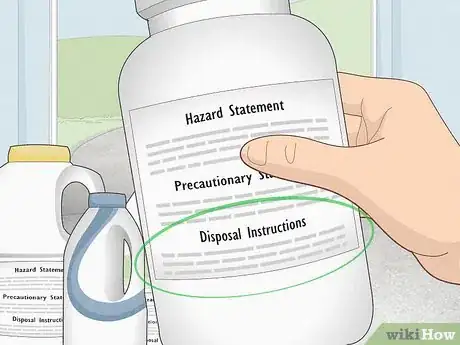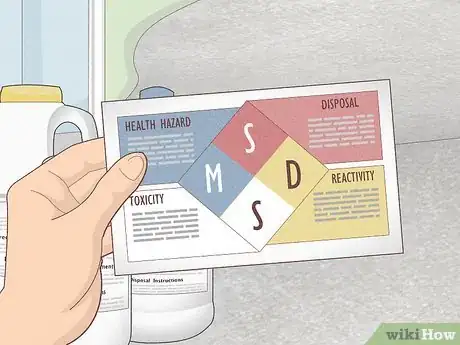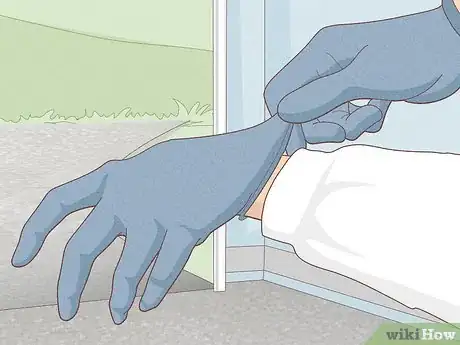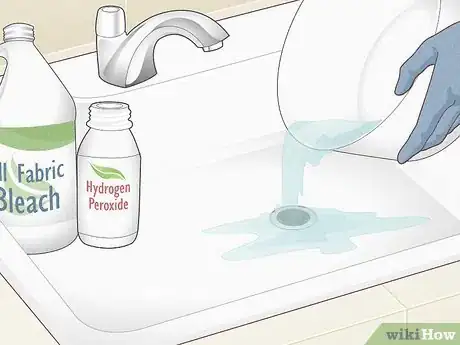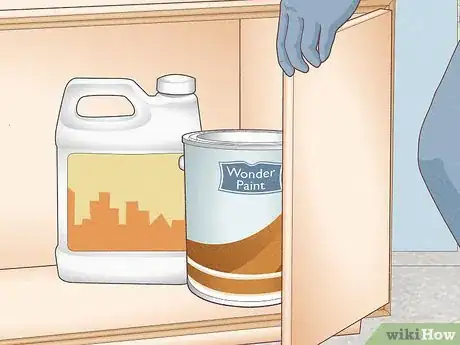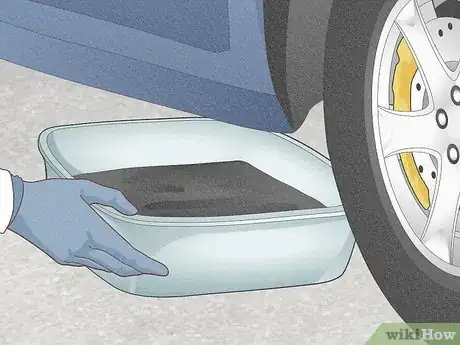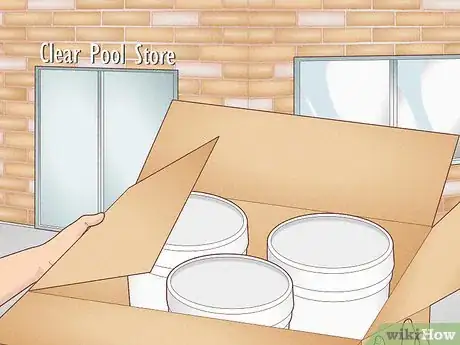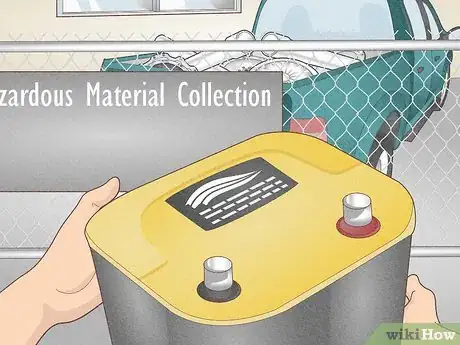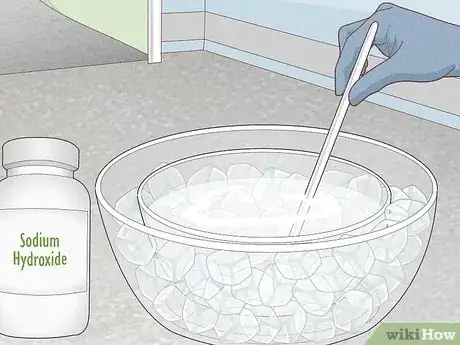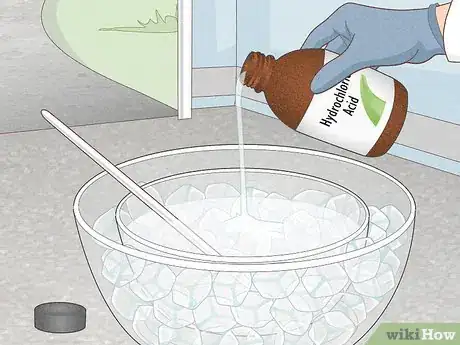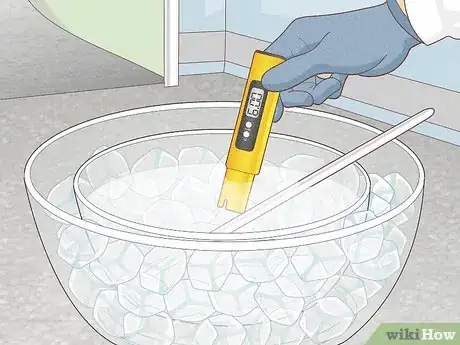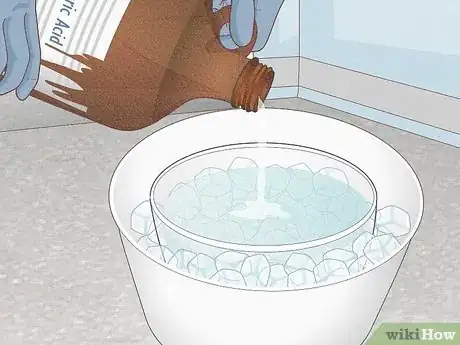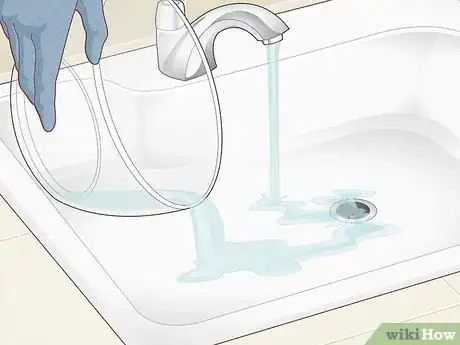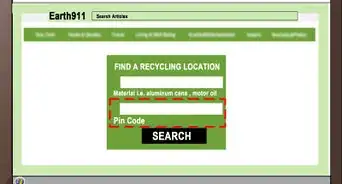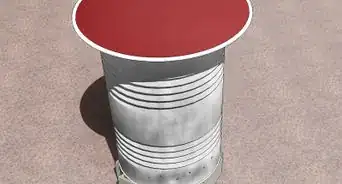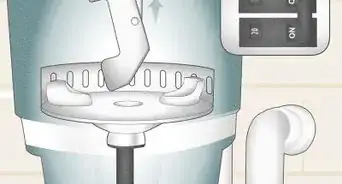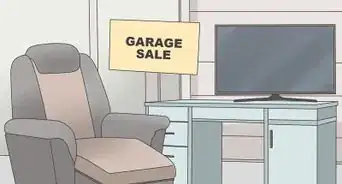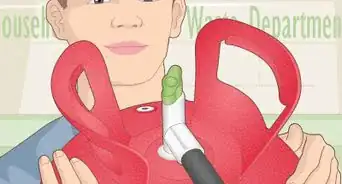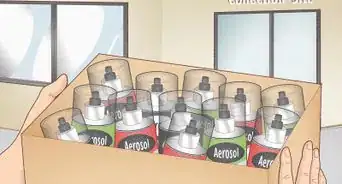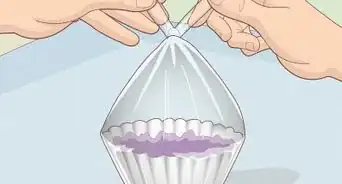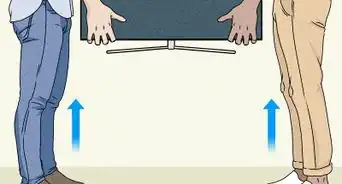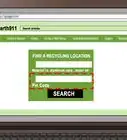This article was co-authored by Meredith Juncker, PhD. Meredith Juncker is a PhD candidate in Biochemistry and Molecular Biology at Louisiana State University Health Sciences Center. Her studies are focused on proteins and neurodegenerative diseases.
There are 11 references cited in this article, which can be found at the bottom of the page.
This article has been viewed 92,397 times.
Many household products and other chemical items create hazardous conditions for humans and the environment. Because of this, a number of steps have been devised for safe and proper disposal of such industrial chemicals. Even though the chemicals will always have some sort of impact, reducing that impact as much as possible is crucial.
Steps
Identifying the Proper Waste Disposal Method
-
1Read the product label. Some chemical products come with disposal instructions right on the label and following those instructions should be enough. Even for products without disposal instructions, you should still read the labels so you can be aware of the warnings and cautions concerning said products.
- Items such as batteries and light bulbs have to be recycled at special recycling centers.
- Never mix cleaning products together. If you only have a small amount of cleaning product left in each bottle, it may be tempting to mix them into one bottle for disposal. Different chemicals can react with each other to form very hazardous fumes and noxious gases.
-
2Read the material safety data sheet. In addition to the product label, you want to read the MSDS for industrial chemicals. The MSDS gives you important information about the chemical: its toxicity, reactivity, and disposal considerations.
- Every chemical product you buy should come with an MSDS sheet. However, you can also use the online MSDS database to look up the MSDS for the specific formulation of the chemical you wish to dispose.[1]
Advertisement -
3Search the list of hazardous wastes. The Environmental Protection Agency (EPA) has many resources on determining if your waste is considered hazardous and what kind of special disposal is necessary. The EPA regulates hazardous waste using the Resource Conservation and Recovery Act of 1976.[2] [3]
- Determine if your waste is hazardous by referring to this EPA flow chart.
- If your waste is classified as hazardous by the EPA, you will need to contact the EPA for proper disposal.
- You can contact the EPA online or by looking up your local EPA office and contacting them directly by phone.[4]
Disposing of Common Chemicals
-
1Use proper safety precautions. When dealing with any chemicals, you should always wear gloves, long-sleeved shirts, pants, goggles, and closed-toe shoes. You want to minimize skin exposure as much as possible. Chemicals often emit noxious fumes, so you want to work in a well-ventilated area.
- Also, make sure to tie back your hair if it is long.
- Never breathe deeply and inhale chemical fumes, particularly if you are unsure of what the chemical is.
- Read all safety information for a chemical before working with it or disposing of it.
- If you get a chemical on your skin or in your eye, seek medical attention right away. You should also immediately rinse the affected area with water for at least 15 minutes.
-
2
-
3Store solvents for special collection. Solvents such as paint and varnish must be disposed of at a special recycling center or collected by a hazardous waste company. Many home improvement stores have paint recycling centers as well.
- Latex paints can be disposed of at home. Stir in an equal part of cat litter to match the amount of paint. Stir until the paint thickens and allow the mixture to sit for one hour. You can throw the hardened paint away in the garbage.[6]
-
4Recycle automotive fluids. Car-related fluids such as antifreeze, motor oil, and transmission fluid can be collected and recycled. None of these items can be thrown away or disposed of down the drain. Collect the fluid and bring it to a nearby recycling center.
- Use a recycling locator to help you find a location near you.[7]
-
5Drain all aerosol canisters. Do this by turning them upside down and spraying them into an absorbent material, like paper towels, rags, or a sponge. Once the can has lost all of its pressure, wrap it in several layers of newspaper and throw it out with regular household trash.[8]
- Alternatively, you can dispose of partially filled cans by taking them to a Household Hazardous Waste collection center.
-
6Return pool chemicals back to your local pool store. Most pool stores will take pool chemicals and dispose of them properly. Alternatively, you can check with the community pool and see if they have any need of your unused chemicals.[9]
- If you must dispose of them in the garbage, make sure the chemicals are dry, stored in their original containers and double-bagged to prevent contamination.
-
7Submit industrial chemicals to a hazardous material collection system. If you are unsure of the proper method of disposal for a potentially dangerous product, like a car battery, seek out a hazardous material collection service nearby and see if they will take your waste. Most communities should have such a service.[10]
- Laboratories have specific waste disposal departments that take care of this. Once you have a full container, schedule a pick-up for disposal.
- Store the used chemical in a proper container for disposal. A sealed plastic container is generally sufficient.[11]
Neutralizing Strong Acids or Bases for Disposal
-
1Know the acids and bases that cannot be neutralized. There are some acids and bases that cannot be neutralized and disposed of down the sewer drain. Disposal of the following should be done through the proper hazardous waste collection channels:
- perchloric acid
- concentrated nitric acid
- fuming (concentrated), sulfuric acid
- hydrofluoric acid
- acids or bases with dyes or surfactants
- acids of bases with heavy metals
- organic acids and bases that remain toxic after neutralization
-
2Identify the strength of the acid or base. Strong acids (pH < 2.0) and strong bases (pH > 12.0) must be neutralized before dilution and disposal down the drain. The strength of the acid or base can be determined using a pH meter or pH strips. Strong acids and bases must be neutralized to a pH range between 6.0 and 9.0.
- A pH meter directly measures the pH of the solution.
- pH paper has a color indicator that tells you the strength of the solution.
-
3Neutralize strong acids with sodium hydroxide. Work in a fume hood (or well-ventilated area) because this process emits noxious fumes. Keep the solution constantly stirring and slowly add sodium hydroxide. This reaction will release heat so it is important that the sodium hydroxide is added slowly. Keep adding sodium hydroxide until the acid is neutralized.
- Placing the container in a second container of ice will help avoid overheating and potential injury.
- You should also wear goggles and a mask to protect yourself from noxious fumes.
-
4Neutralize strong bases with hydrochloric acid. The process of neutralizing a strong base is the same as neutralizing a strong acid except you use hydrochloric acid instead of sodium hydroxide. Slowly add the hydrochloric acid to the strong base while constantly stirring the solution.
- This reaction also releases heat, so add slowly and keep the container in a bucket of ice to avoid superheating the container.
-
5Check the pH again. After neutralization, the pH should be in the range between 6.0 and 9.0. Use the pH meter or pH paper strips to ensure the proper neutralization of the acid or base. If the pH is not in the correct range, continue adding the neutralizing acid or base to the solution until the correct pH is reached.
- Acid-base indicator solutions can also be used to test the pH of the solutions. As the pH of the entire solution changes, the color of the indicator will change. If you have access to an indicator, it can make your neutralization process easier.[12]
-
6Dilute by adding acid or base to water. To dilute the solution, always add the acid or the base directly to the water. Adding water to the acid or base can superheat the water and lead to explosions.
- Diluting the acid or base is an exothermic reaction, meaning it will give off heat. Place the container in an ice bucket to avoid superheating the container.
- You can calculate the amount of water needed to dilute the solution based on the strength of the acid or base.
-
7Pour it down the drain. Once the solution has been neutralized and diluted, it can be poured directly down the drain. Keep the water running while you pour the solution down the drain to further dilute.[13]
- If the waste contains a heavy metal such as copper, lead, zinc, cadmium, or mercury, you cannot dispose of it down the sink. It must be disposed of as hazardous waste by an environmental health and safety office.
Expert Q&A
Did you know you can get expert answers for this article?
Unlock expert answers by supporting wikiHow
-
QuestionHow do I safely dispose of a liquid, silver jewelry cleaner? It is 15 years old and smells like sulfuric acid.
 Meredith Juncker, PhDMeredith Juncker is a PhD candidate in Biochemistry and Molecular Biology at Louisiana State University Health Sciences Center. Her studies are focused on proteins and neurodegenerative diseases.
Meredith Juncker, PhDMeredith Juncker is a PhD candidate in Biochemistry and Molecular Biology at Louisiana State University Health Sciences Center. Her studies are focused on proteins and neurodegenerative diseases.
Scientific Researcher You are correct, most silver jewelry cleaners contain sulfuric acid. I would check with your local, state, or federal regulatory agencies regarding proper disposal of this cleaner. Since this is an old version of the cleaner, maybe you can find a newer version online and look at that particular MSDS sheet for more information.
You are correct, most silver jewelry cleaners contain sulfuric acid. I would check with your local, state, or federal regulatory agencies regarding proper disposal of this cleaner. Since this is an old version of the cleaner, maybe you can find a newer version online and look at that particular MSDS sheet for more information.
Warnings
- Do not pour the remainder of a product onto the ground outside and never burn the remainder of a product on the ground outside. These acts are very dangerous.⧼thumbs_response⧽
- Be very careful with bottles and cans that appear to be empty. Just because you can't get any more liquid out of a product does not mean that it is void of harmful chemicals. Even an "empty" container needs to be disposed of safely and properly.⧼thumbs_response⧽
- Do not pour a chemical down any sink or toilet unless the product label explicitly says that it is safe to do so. If you have your own septic tank, disposal through drains should always be avoided.⧼thumbs_response⧽
References
- ↑ http://msds.com/
- ↑ https://www.epa.gov/hw/criteria-definition-solid-waste-and-solid-and-hazardous-waste-exclusions
- ↑ https://www.epa.gov/hw/defining-hazardous-waste-listed-characteristic-and-mixed-radiological-wastes
- ↑ https://www.epa.gov/home/forms/contact-epa
- ↑ http://cool.conservation-us.org/waac/wn/wn06/wn06-2/wn06-205.html
- ↑ https://www.lowes.com/n/how-to/store-dispose-paint-properly
- ↑ http://earth911.com/recycling-guide/how-to-recycle-automotive-fluids/
- ↑ https://household-tips.thefuntimesguide.com/2010/06/recycling_trash.php
- ↑ http://www.mydisposal.com/dispose-old-pool-chemicals
- ↑ http://cool.conservation-us.org/waac/wn/wn06/wn06-2/wn06-205.html
- ↑ http://blink.ucsd.edu/safety/research-lab/hazardous-waste/chemical.html#Select-compatible-containers
- ↑ http://www.chemguide.co.uk/physical/acidbaseeqia/indicators.html
- ↑ http://cool.conservation-us.org/waac/wn/wn06/wn06-2/wn06-205.html
About This Article
Disposing of industrial chemicals improperly can harm the environment and cause illness, but fortunately there are a variety of safe disposal methods to prevent that. When you need to get rid of a chemical, always read the product label first to see if it has disposal instructions. For example, the label might tell you to take the chemical to a special recycling center or that it’s safe to pour down the drain. Many home improvement stores offer special recycling facilities for substances like paint and automotive fluids. If you need to get rid of a household chemical, like bleach or hydrogen peroxide, dilute it with 10 parts water. Let the solution sit for at least an hour, then pour it down the drain. To learn how to neutralize strong acids or bases before disposing of them, read on!
